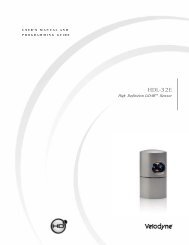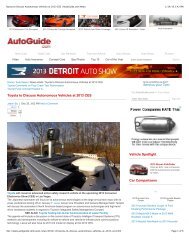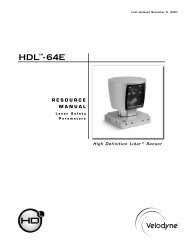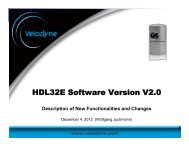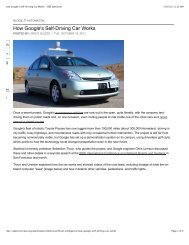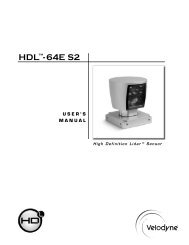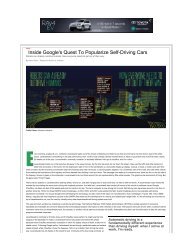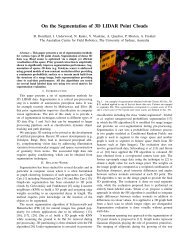RUAG Presents Two Unmanned Ground Vehicle ... - Velodyne Lidar
RUAG Presents Two Unmanned Ground Vehicle ... - Velodyne Lidar
RUAG Presents Two Unmanned Ground Vehicle ... - Velodyne Lidar
You also want an ePaper? Increase the reach of your titles
YUMPU automatically turns print PDFs into web optimized ePapers that Google loves.
http://www.unmannedsystemstechnology.com/2012/09/ruag-presents-two-unmanned-groundvehicle-projects-at-m-elrob/<br />
<strong>RUAG</strong> <strong>Presents</strong> <strong>Two</strong> <strong>Unmanned</strong> <strong>Ground</strong><br />
<strong>Vehicle</strong> Projects at M-ELROB<br />
Tuesday, September 25th, 2012Source: <strong>RUAG</strong><br />
UGVs (unmanned ground vehicles) – also known as land robots – are used for<br />
protection or rescue duties in hazardous environments, or for the performance of<br />
frequently reoccurring, repetitive tasks. The context can be military as well as a<br />
civilian. UGVs are typically deployed for reconnaissance work, monitoring buildings<br />
and infrastructures, border surveillance, search and rescue missions and goods<br />
transport, as well as explosive ordnance disposal and mine clearance. UGVs can be<br />
compared to unmanned airborne systems, except that ground deployment presents<br />
scientists and technicians with challenges that are several orders more complex and<br />
difficult.<br />
<strong>RUAG</strong> Defence CEO Urs Breitmeier comments: “UGVs are a highly promising<br />
technology of the future, and one that <strong>RUAG</strong> is actively pursuing. <strong>RUAG</strong> is<br />
researching, developing and investing in this area with the aim of gradually becoming<br />
a UGV competence centre for the Swiss Army and other security forces.”<br />
<strong>RUAG</strong> is attending this year’s M-ELROB, which is taking place in Switzerland for the<br />
first time, with two projects:<br />
ARTOR (Autonomous Rough-Terrain Outdoor Robot) research project<br />
<strong>RUAG</strong> ARTOR UGV
ARTOR is a research project involving a group of specialists from the Federal<br />
Institute of Technology Zurich (ETHZ), from technical departments at armasuisse,<br />
and <strong>RUAG</strong>. The objective of this project is to improve the autonomy of a ground<br />
vehicle. The point of the UGV research programme as a whole is the setting up of a<br />
UGV competence centre in Switzerland. The programme is primarily driven by<br />
Switzerland’s public safety and security requirements, not by the marketing<br />
possibilities presented by the technology.<br />
ARTOR is already capable of navigating autonomously: rather than use GPS, it relies<br />
on data captured by sensors mounted on the vehicle. ARTOR is able to negotiate<br />
static and moving obstacles as its picks out the quickest way to its target via a<br />
number of via predetermined waypoints. It is also able to follow vehicles or people<br />
and can search for a route or area autonomously.<br />
<strong>Two</strong> vehicular devices have been developed, both featuring electric propulsion: one is<br />
a wheeled vehicle approximately 100 cm long and 80 cm wide weighing 250 kg with a<br />
payload capability of 100 kg. The other is a tracked vehicle approximately 170 cm<br />
long and 80 cm wide weighing 425 kg with a payload capability of around 200 kg.<br />
Maximum speed for both exceeds 15 km/h. The average deployment time on a single<br />
battery charge is in the order of four hours. Depending on what is required of them,<br />
the vehicles can rapidly be equipped with a range of standard payloads.<br />
Technology demonstrator based on an EAGLE 4×4 featuring the <strong>RUAG</strong> <strong>Vehicle</strong><br />
Robotic Kit<br />
This project is a joint venture involving <strong>RUAG</strong> and General Dynamics European Land<br />
Systems (GDELS), and is aimed at developing a UGV technology demonstrator<br />
based on a standard military vehicle that is otherwise normally manned. In the<br />
partnership, GDELS is delivering the Eagle 4×4 vehicle with an all-important vehicle<br />
assistance system, while <strong>RUAG</strong> is responsible for integrating the additional<br />
equipment required for UGV operation, such as sensors, control computers<br />
(hardware and software), actuators, the broadband radio system and the control and<br />
command equipment for the control console. The vehicle is currently teleoperated,<br />
i.e. operated under remote control, but its autonomy will improve as development<br />
work progresses.<br />
<strong>RUAG</strong> is developing and delivering most of the UGV component groups in kit form.<br />
The kit is designed in such a way that it can be used with almost any vehicle. In<br />
addition, the control console can be installed in a container or another vehicle. The<br />
vehicle can be operated in a manned or manned mode. It measures 5.5 m in length,<br />
2.3 m in width and 2.4 m in height. Its maximum weight is 10,000 kg and it can carry<br />
a payload of around 3000 kg.




